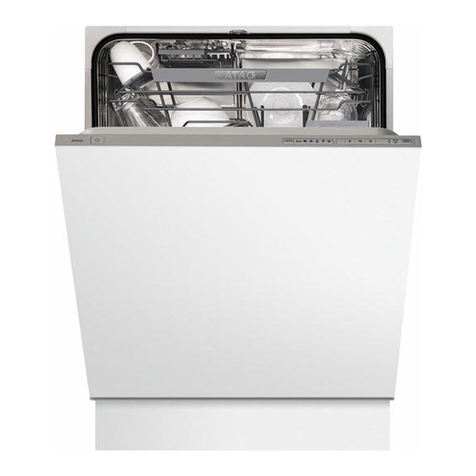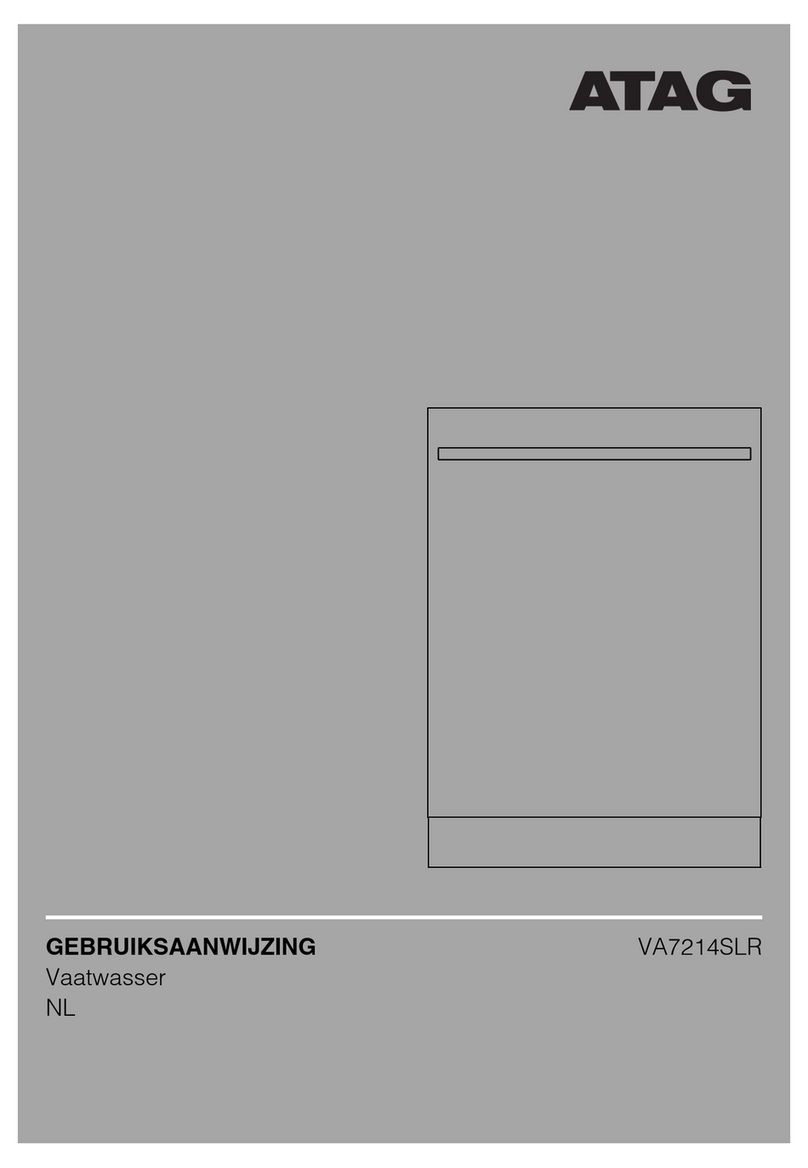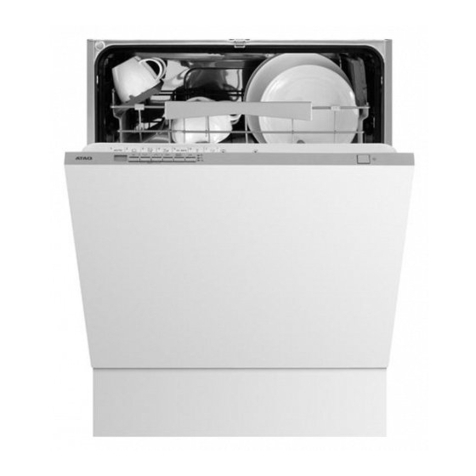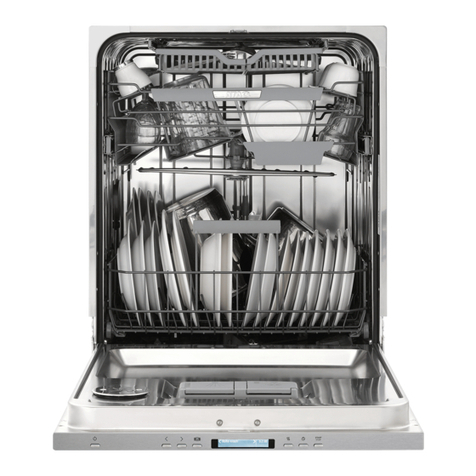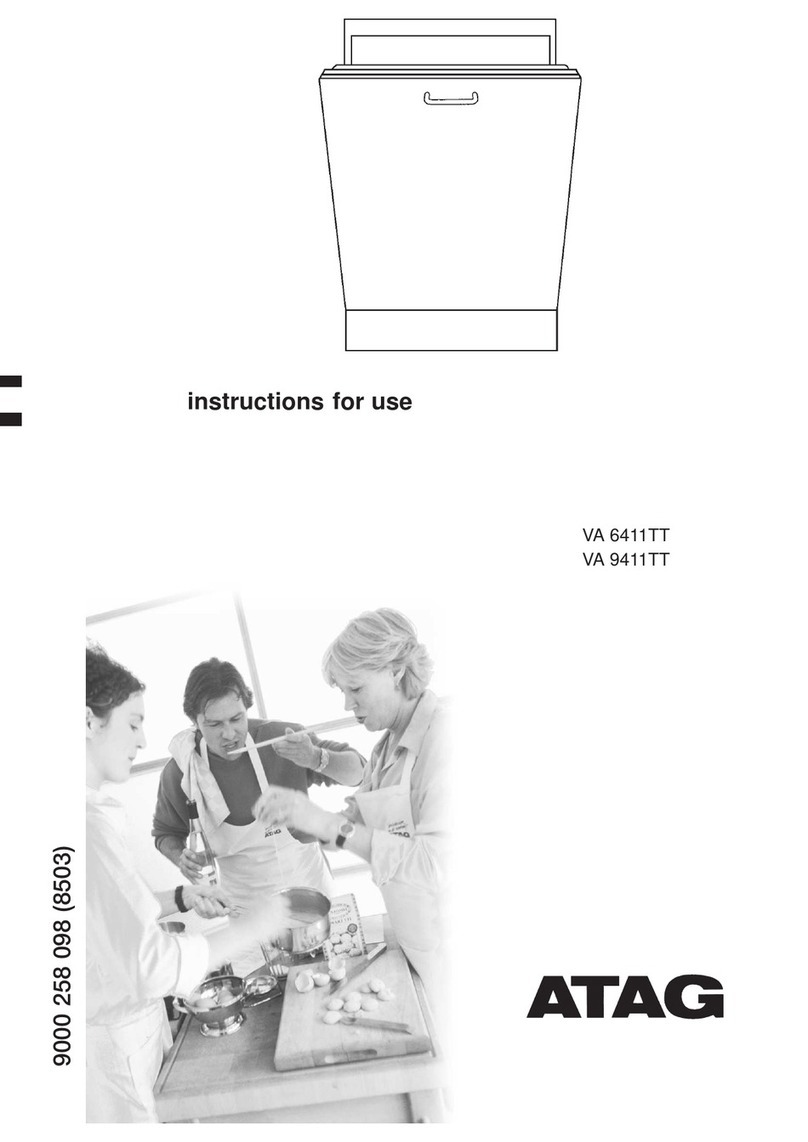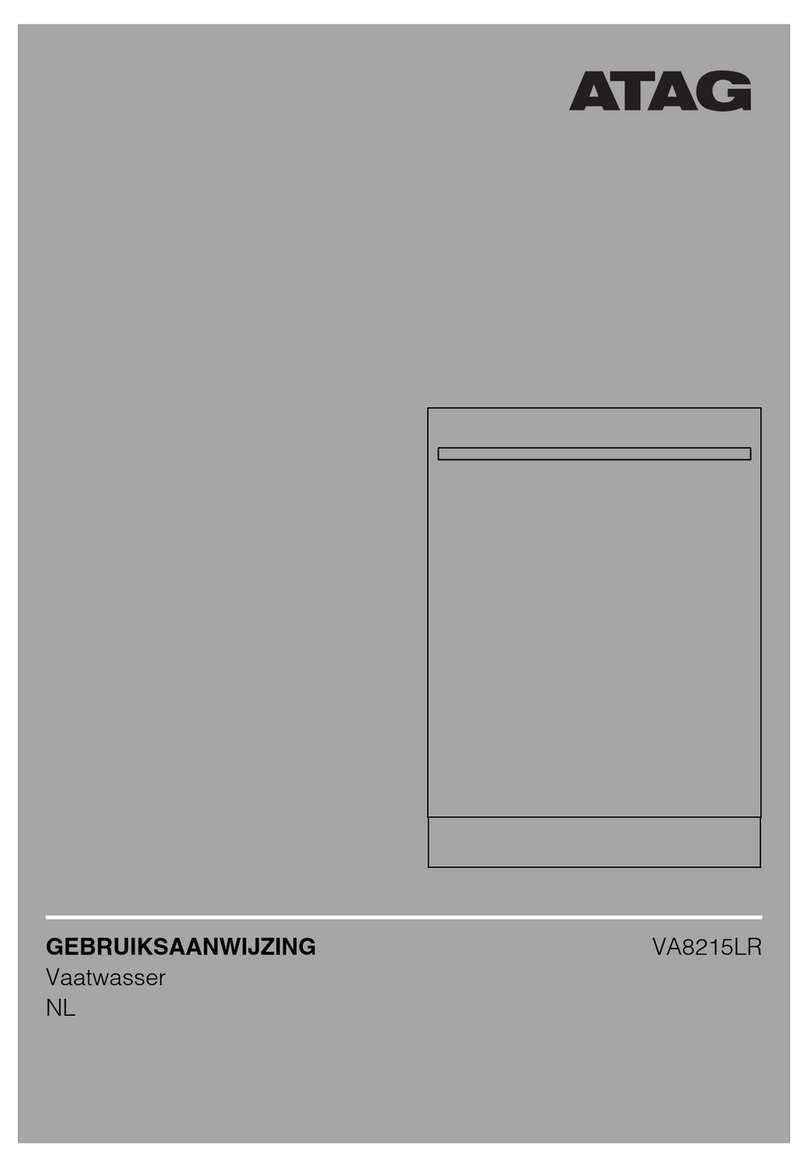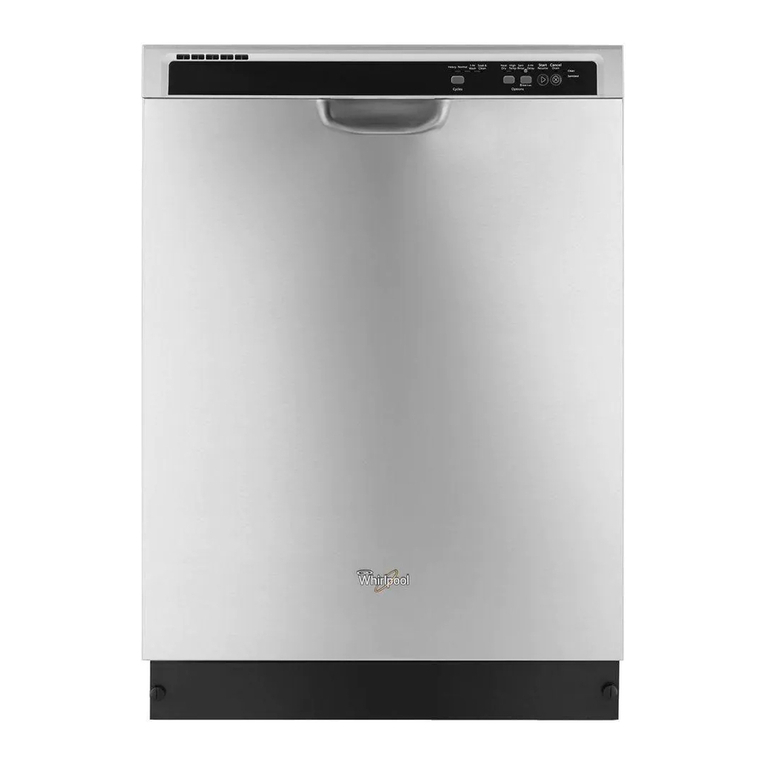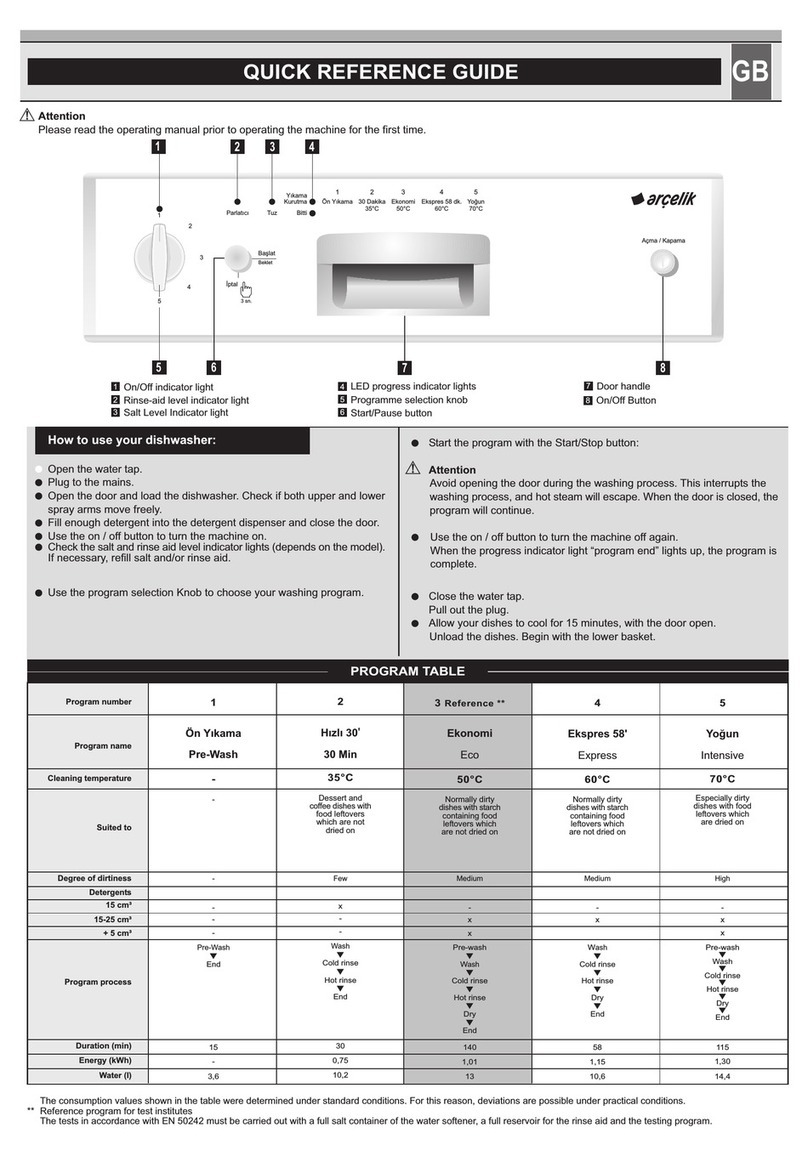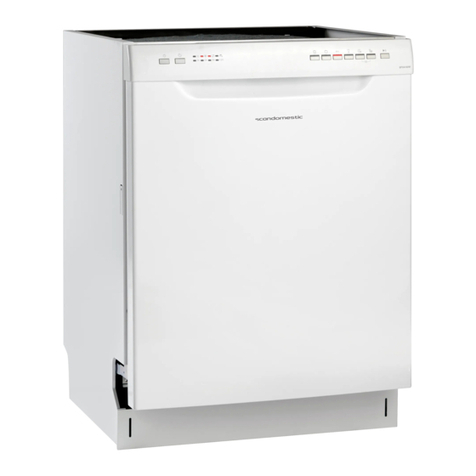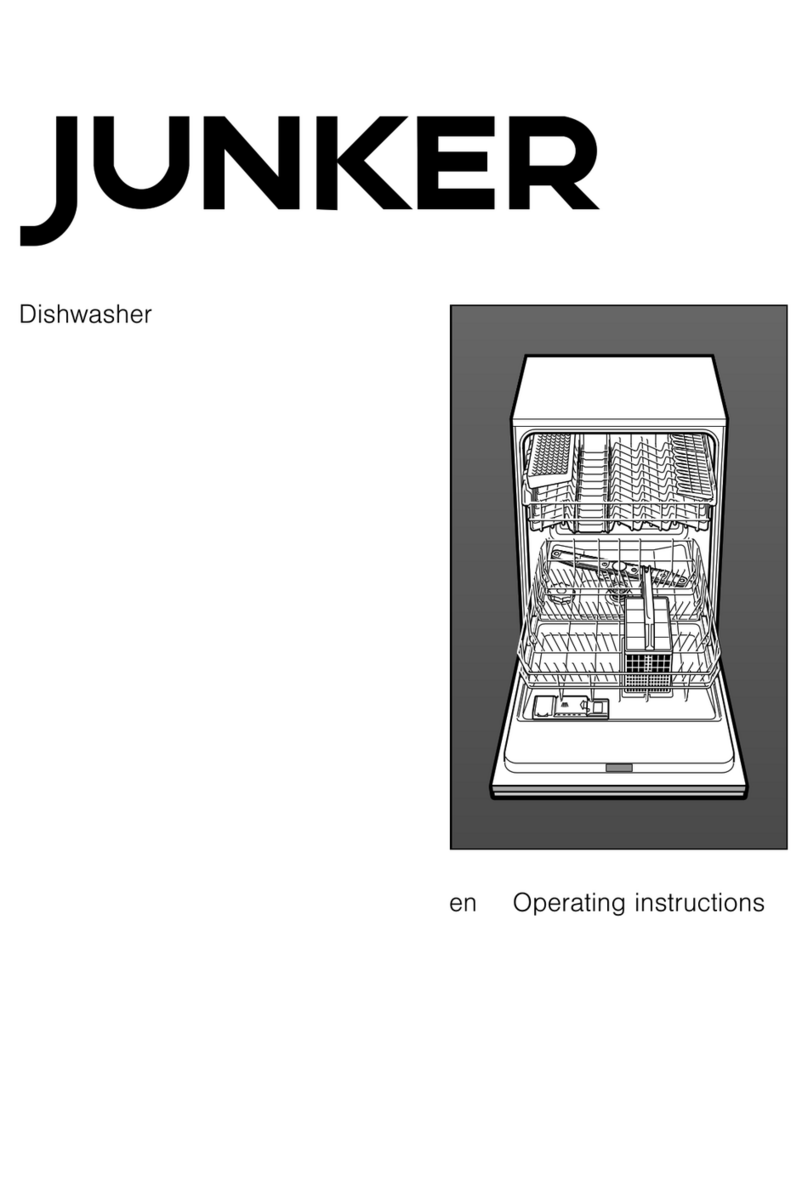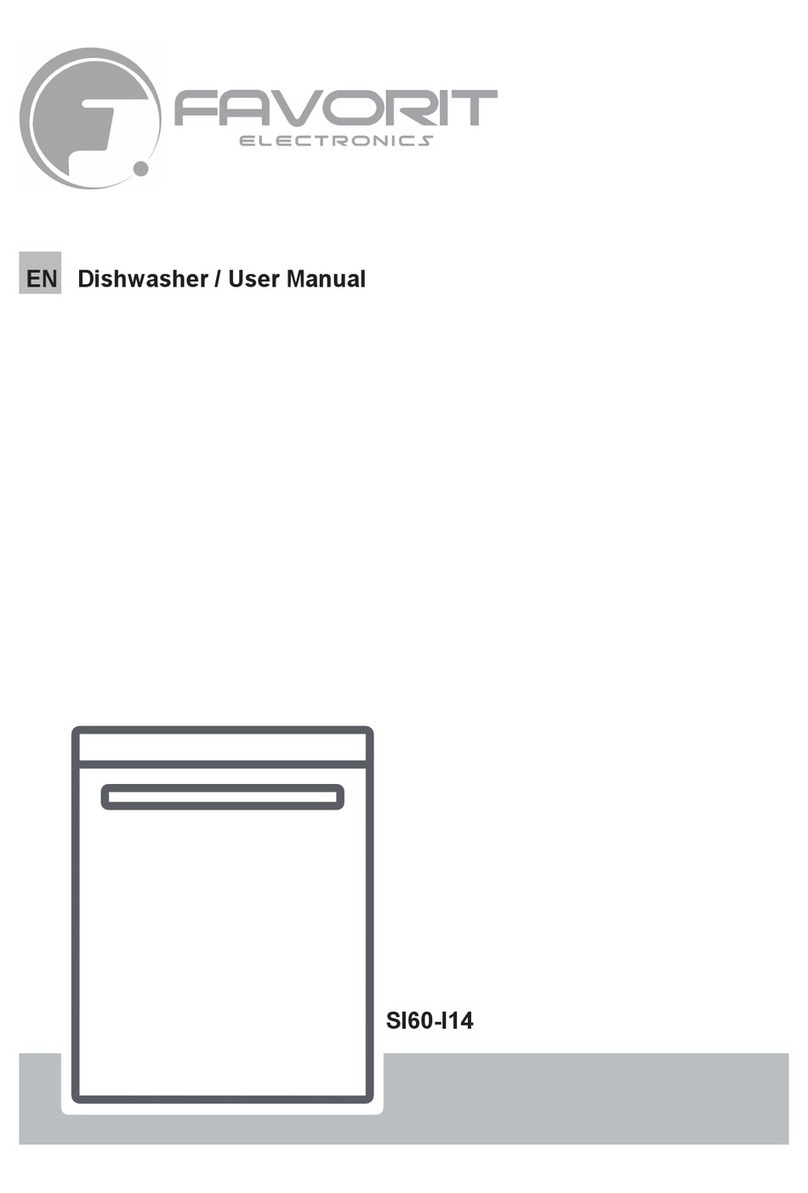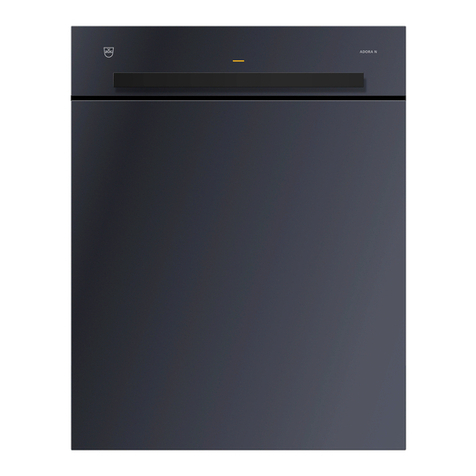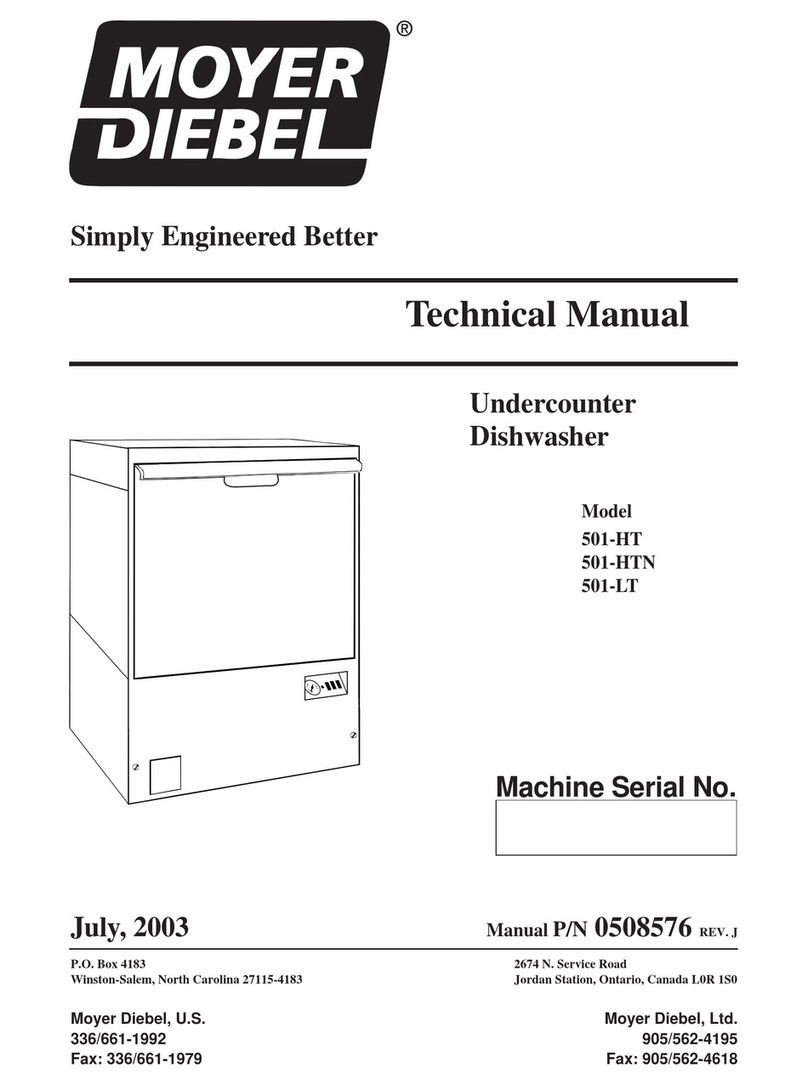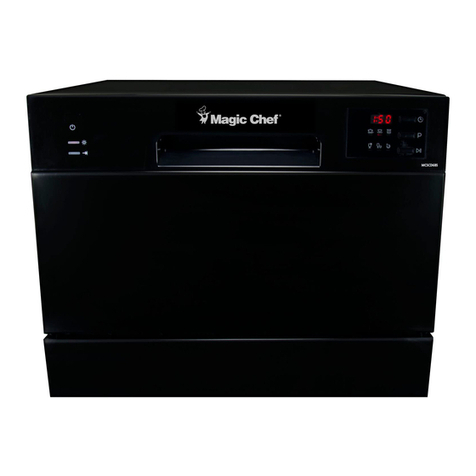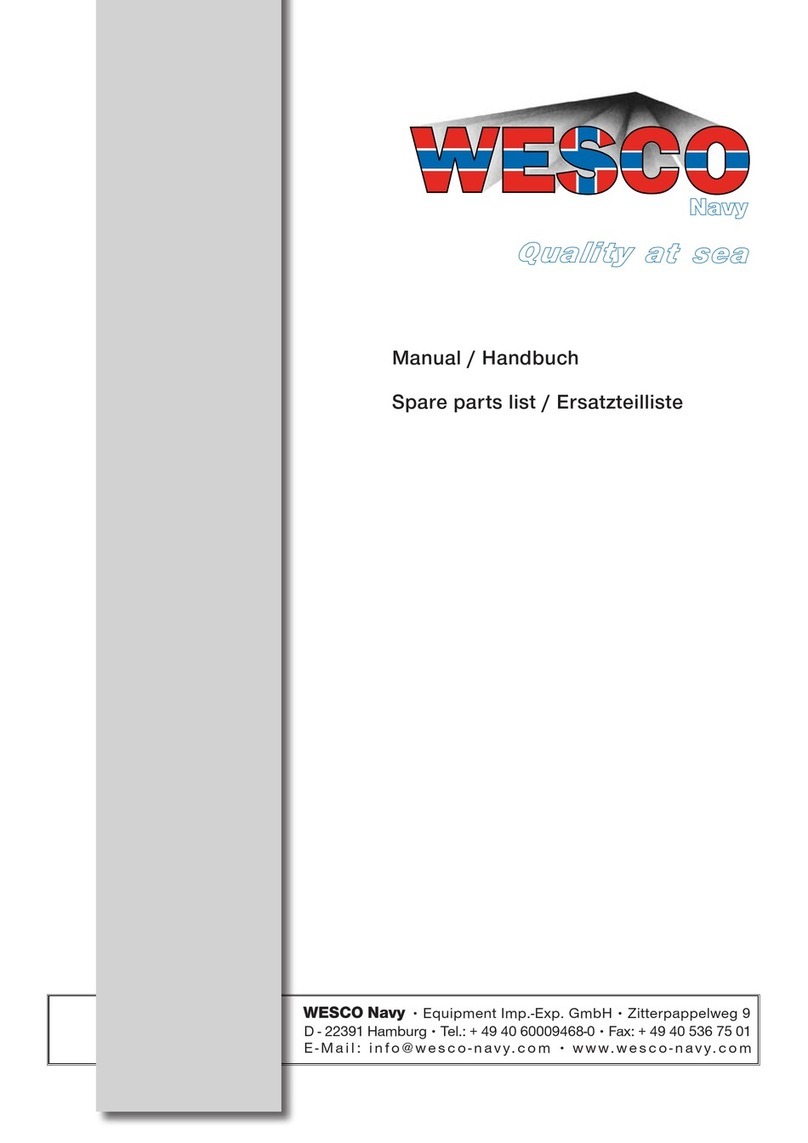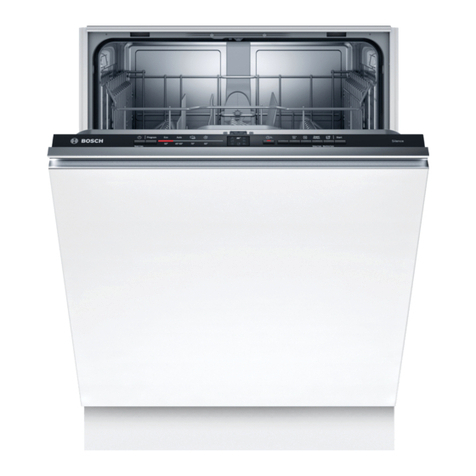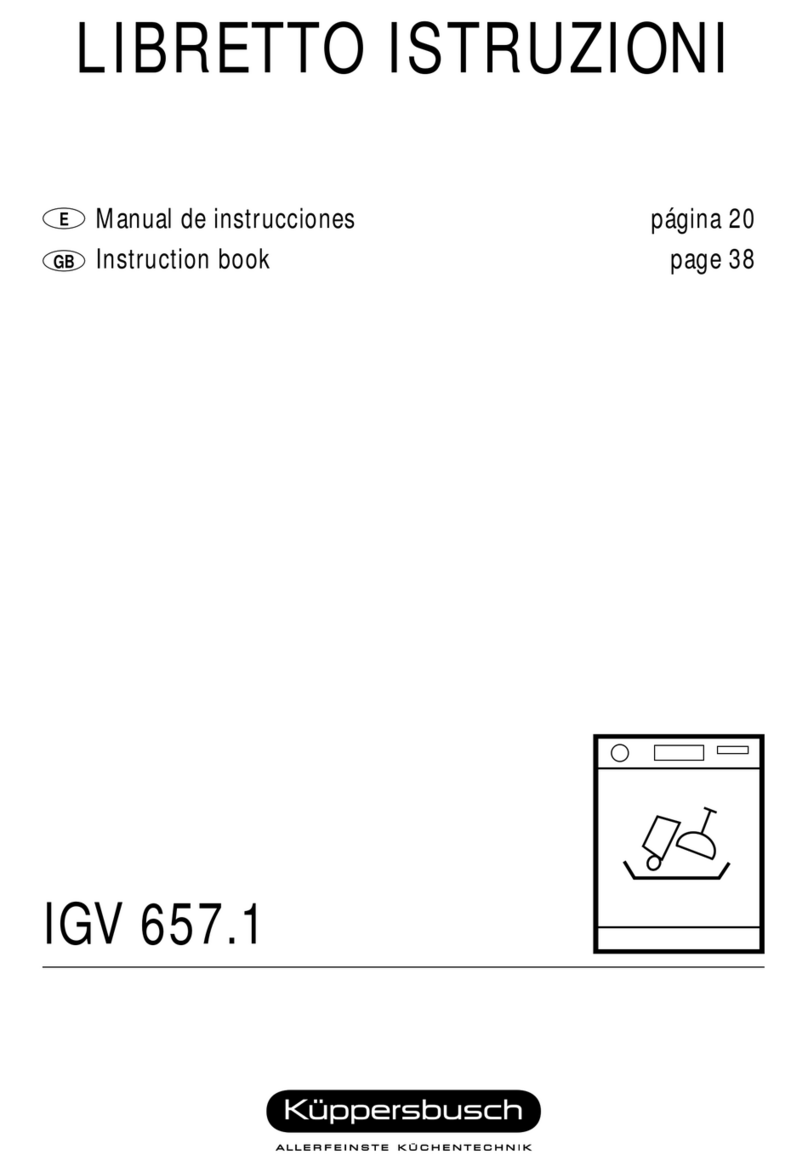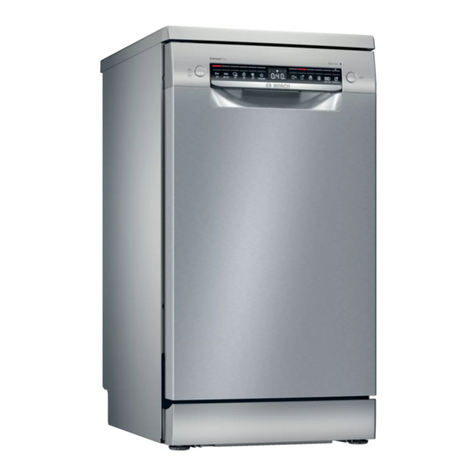Atag VA8015QT User manual

Operating Instructions
VA8015QT

Contents
2Front panel
3Safety instructions
4Before washing for the first time
6Loading the dishwasher
8Using the dishwasher
12Settings
14Care and cleaning
16Troubleshooting
19Technical information
20Installation
21Service
22Information for test institute
23Your notes
24Quick guide
Dear ATAG customer!
We hope that you will have many years of use from your new machine.
To get the most out of your new dishwasher, we recommend that you read the operating instructions before using the
dishwasher. The last page also includes a Quick guide.
Front panel
To switch on the dishwasher, press and hold the main power switch until the display lights up.
"This is a first time set up." is shown on the display the first time the dishwasher is switched on. It is important that you choose the
right settings to ensure good dishwashing results. See page 4.
Eco
Speed mode
2:00
START
STOP
Display Start/Stop
Programme mode selector
Navigation buttons for selecting a programme
Option Delayed Start
Option Extra Dry
Main power switch
2

Safety instructions
•Read the operating instructions and keep
them in a safe place!
•Number of standard place settings: 13
•Never use the dishwasher for any purpose
other than that specified in these operating
instructions.
•Do not load the dishwasher door or
dishwasher baskets with anything other than
dishes.
•Never leave the dishwasher door open as
someone may trip on it.
•Use only dishwasher detergent!
•This machine can be used by children aged
8 and upwards, and by people with reduced
physical capacity, mental ability, memory loss
or lacking experience and knowledge. These
individuals must be supervised when using
the machine or have instructions on how to
use the machine and understand the risks that
can occur. Cleaning of the machine must not
be carried out by children without supervision.
•Children must be watched to ensure they do
not play with the dishwasher.
•Damaged mains cables must only be
replaced by a qualified electrician.
•Only use the dishwasher in household-type
environments for dishwashing household
dishes. All other use is prohibited.
•Never place dishes with solvent residues in
the dishwasher due to the risk of explosion.
Nor may dishes that contain ash, wax or
lubricants be washed in the dishwasher.
WARNING!
Knives and other pointed items must be placed
with the points down in the cutlery basket or
horizontally in other baskets.
Installation
See the section Installation.
Child safety
•Always start the dishwasher immediately after
adding detergent.
•Keep children away from the dishwasher when
the door is open. Some detergent may remain
inside!
•Do not allow children to use or play with the
dishwasher. Be especially vigilant when the
door is open.
WARNING!
Children must be supervised –dishwasher
detergent is corrosive!
Activate child lock (button lock)
You can activate the child lock (button lock) to prevent children from
starting the dishwasher. See the chapter Settings.
Winter storage/Transport
•Store the dishwasher where the temperature remains above freezing.
•Avoid long transport distances in very cold weather.
•Transport the dishwasher upright or laying on its back.
Overflow guard function
The overflow protection starts pumping out the machine and turns off
the water supply if the water level in the dishwasher exceeds the normal
level. If the overflow protection is triggered, turn off the water supply
and call the service department.
Packing material
The packaging protects the product during transport. The packaging
material is recyclable. Separate the different packaging materials to
help reduce raw material use and waste. Your dealer can take the
packaging for recycling or direct you to the nearest recycling centre.
The packaging is comprised of:
•Corrugated cardboard made from up to 100% recycled material.
•Expanded polystyrene (EPS) with no added chlorine or fluorine.
•Supports made from untreated wood.
•Protective plastic made from polyethylene (PE).
Disposal
•When the dishwasher has reached the end of its service life and is
to be disposed of, it should immediately be made unusable. Pull
out the power cable and cut it as short as possible.
•The dishwasher is manufactured and labelled for recycling.
•Contact your local authority for information about where and how
your dishwasher should be correctly recycled.
3

Before washing for the
first time
1. Checking water hardness
In order to achieve good dishwashing results, the dishwasher needs
soft water (water with low mineral content). Hard water leaves a white
coating on dishes and the dishwasher.
Water hardness is specified using the following scales: The German
water hardness scale (°dH) and the French water hardness scale (°fH).
A water supply with a water hardness in excess of 6°dH (9°fH) must
be softened. This is done automatically with the aid of the built-in water
softener. In order for the softener to function optimally, it must be
adjusted to the hardness of the water supply.
Contact the local waterworks, or measure the water hardness using
the supplied test strip, to check the water hardness in your area. Once
you have adjusted the water softener, use detergent and rinse aid
doses suitable for soft water.
How to use the test strip:
1 Turn on the water tap and let the water run for a minute or so.
2 Fill a glass with water.
3 Remove the test strip from its packaging.
4 Dip the test strip in the water for about one second.
5 Wait one minute. Now compare the colours of the squares with the
water hardness table.
°fH°dHTest strip
<5<3
4 green
>7>4
1 red
>15>8
2 red
>25>14
3 red
>38>21
4 red
2. Basic settings
To switch on the dishwasher, press and hold the main power switch
until the display lights up.
"This is a first time set up." is shown on the display. It is important
that you choose the right settings to ensure good dishwashing results.
Confirm setting
Select setting
Main power switch
Settings
Language1
Select the language to be shown on the display.
Rinse aid 0/1/2/3/4/5/TAB2
Drying is faster and a better result is achieved if you use rinse aid.
You will also achieve a better dishwashing result with clear and
spotless dishes.
Select rinse aid dosage. The rinse aid dispenser can be adjusted
between 0 (Off) and 5 (High dosage).
When using an all-in-one detergent that contains rinse aid, you can
activate the setting TAB. Read more about all-in-one detergent in the
chapter Using the dishwasher.
Pre-selected at factory: 5
Water hardness 0/1/2/3/4/5/6/7/8/93
Choose a setting depending on the hardness of the water supply.
See the water hardness table below. It is important that this setting
is correct!
°dH
0-5
6-8
9-11
12-14
15-19
20-24
25-29
30-39
40-49
50+
0-9
10-14
15-20
21-25
26-34
35-43
44-52
53-70
71-88
89+
°fH °dH °fH
Do not forget to put salt in the salt compartment after you have set
the water softener to 1 - 9.
For a water supply with a hardness under 6°dH (9°fH), select 0. The
water softener is deactivated and no salt is needed.
Pre-selected at factory: 4
To change the chosen setting, see the chapter Settings.
4

3. Top up with rinse aid
Drying is faster and a better result is achieved if you use rinse aid. You
will also achieve a better dishwashing result with clear and spotless
dishes.
Press to open
1 Open the rinse aid compartment lid.
2Carefully top up with rinse aid. Only add rinse aid to the level marked
max.
3 Wipe up any splashes of rinse aid around the compartment.
4 Close the lid firmly.
Top up rinse aid
When the rinse aid needs topping up, the above symbol lights on the
display.
After topping up, it may take a while before the symbol goes out.
NOTE!
Increase the rinse aid dosage:
•If the dishes have water marks.
Decrease the rinse aid dosage:
•If the dishes have a sticky white/blue film.
•If the dishes are streaked.
•Build-up of foam. If you have very soft water, the rinse aid can be
diluted 50:50 with water.
4. Top up with salt
Before you begin using a dishwasher with a water softener, you must
fill the salt compartment with salt for the water supply to be softened
automatically. Use large grain salt or special dishwasher salt.
WARNING!
In order to avoid rust stains a dishwashing programme must be
started immediately after adding salt.
Never pour dishwasher detergent into the salt compartment. This
destroys the water softener!
Do as follows the first time:
1 Unscrew the lid as illustrated.
2 Place the funnel supplied with the dishwasher in the salt
compartment top-up hole. First, pour in about 1 l of water.
3 Then add salt, a maximum of 1.0 kg, until the compartment is full.
4 Wipe up any excess salt so that the lid can be screwed on firmly.
5Run a programme to ensure that any salt in the dishwasher is rinsed
away.
Salt compartment lid
Top up salt
When the salt needs topping up, the above symbol lights on the display.
When the salt runs out, unscrew the cap and fill the container with salt.
Water is only needed the first time! Wipe clean and tighten. Run a
programme to ensure that any salt in the dishwasher is rinsed away.
After topping up, it may take a while before the symbol goes out.
5

Loading the dishwasher
Energy-efficient dishwashing
Run programmes only with a full load
Wait to run a programme until the dishwasher is full, this way you save
energy. Use the Rinse and hold programme to rinse the dishes if there
are any unpleasant odours while you wait for the dishwasher to become
fully loaded.
Run programmes at a lower temperature
If the dishes are only slightly dirty, you can select a programme with
a low temperature.
Select Green mode
The dishwasher has different programme modes. To save energy and
water, use Green mode.
Better drying results are achieved if you open the door a little once the
programme has ended. (If the dishwasher is built-in the surrounding
furnishings must be resistant to any condensation from the dishwasher.)
Do not rinse under running water
Simply scrape off large food particles before loading the dishwasher.
Choose a green detergent
Read the environmental declaration on the packaging!
Connect to cold water
Connect the dishwasher to the cold water supply if the building is
heated using oil, electricity or gas.
Connection to hot water supply
Connect the dishwasher to the hot water supply (max. 70 °C) if the
building is heated using an energy-efficient means such as district
heating, solar power or geothermal power. Choosing a hot water
connection cuts dishwashing times and reduces the dishwasher's
energy consumption.
NOTE!
Do not exceed the permitted water supply temperature. Certain
materials used in some cookware cannot withstand strong heat.
Fragile dishes
Some cookware is not dishwasher safe. This can be for several reasons.
Some materials cannot withstand strong heat, others can be damaged
by dishwashing detergent.
Exercise caution with, for example, handmade items, fragile decoration,
crystal/glassware, silver, copper, tin, aluminium, wood and plastic.
Look for the "Dishwasher safe" marking.
Fragile decoration
Porcelain with decoration on top of the glazing (the items feel rough)
should not be washed in a dishwasher.
Crystal/Glass
Wash fragile items made of crystal/glass using the gentle dishwashing
programme Crystal glass. Remember to use a small amount of
detergent and to place items so that they do not touch each other
during the wash.
Drying is faster and a better result is achieved if you use rinse aid. You
will also achieve a better dishwashing result with clear and spotless
dishes.
Hand-painted glassware, as well as antique and very fragile items,
should not be washed in a dishwasher.
Silver
Silver and stainless steel items should not come into contact, as the
silver can become discoloured.
Aluminium
Aluminium can lose its shine if washed in a dishwasher. However, good
quality aluminium pans can be washed in a dishwasher, even if some
of the shine will be lost.
Cutlery with glued handles
Some types of glue are not dishwasher safe. In such cases, the handles
may loosen.
Points to consider
•All dirty surfaces should face inwards and downwards!
•Dishes should not be placed in or on each other.
•Angle dishes with hollows, such as cups, so that the rinse water
will run off. This is also important for plastic items.
•Make sure small items cannot fall through the dishwasher basket;
place them in the cutlery basket.
NOTE!
Check that the spray arms can rotate freely.
6

The dishwasher's baskets
The dishwasher is equipped with an upper basket and a lower basket
with a cutlery basket.
The appearance of the baskets may differ depending on the dishwasher
setup.
Upper basket
Place glasses, cups, bowls, side plates and saucers in the upper
basket. All dirty surfaces should face inwards and downwards! Wine
glasses are placed on the wine glass shelf and knives are placed in
the knife stand on the right (if fitted).
Raising the upper basket
1 Pull out the upper basket.
2 Grab the sides of the upper basket with both hands and lift it up.
Lowering the upper basket
1 Pull out the upper basket.
2 Pull out the two locking handles on either side to lower the upper
basket.
Lower basket
Place plates, side plates, serving dishes, pots and cutlery (in the cutlery
basket) in the lower basket.
Place pots and pans in the rear right of the lower basket to best utilise
dishwashing performance from the rear spray nozzle, which is intended
for these types of dishes.
Foldable tines
Lower the foldable tines (plate supports) when washing pots. Release
the foldable tines by pressing the catch inwards before adjusting their
position.
Washing large plates
Move foldable tines and their mounts to widen the distance between
the tine rows to adapt the lower basket to plates with a diameter greater
than 25 cm.
Cutlery basket
Place cutlery with the handles facing down, except for knives, and
spread them out as much as possible. Ensure that spoons do not stack
inside each other.
The cutlery basket is best placed in the middle at the front of the lower
basket to best utilise dishwashing performance from the unique spray
nozzle, which is intended for the cutlery basket.
WARNING!
Knives and other pointed items must be placed with the points down
in the cutlery basket or horizontally in other baskets.
Fold-down section for small items
The cutlery basket has a fold-down section in the middle for small
items, or small shafts, such as electric whisk attachments.
7

Cutlery basket with lid
The cutlery basket lid can be removed and used, for example, as an
extra cutlery basket in the upper basket (see below).
Using the dishwasher
Add detergent
Press to open
1 Prewash detergent compartment
2 Main wash detergent compartment
Detergent is added according to water hardness.
Follow the instructions on the detergent packaging. This dishwasher
is fitted with a water softener, so use detergent and rinse aid doses
suitable for soft water.
Too much detergent can result in less effective dishwashing and also
entails greater environmental impact.
The detergent compartment must be dry when adding detergent. There
is one compartment for the prewash and one for the main wash. If
powder or liquid dishwasher detergent is used, add a small amount
of the detergent to the prewash compartment. Contact the detergent
manufacturer if you have questions about the detergent.
NOTE!
Use only dishwasher detergent! Washing up liquid must not be used
as the foam that forms prevents the dishwasher from operating
effectively.
Dishwasher tablets
Halve the tablet if it is difficult to close the dispenser lid. There is a risk
that the detergent will not be released properly if the lid is tight and
will not open correctly.
NOTE!
Dishwasher tablets are not recommended for short programmes
(less than 75 minutes). Use powder or liquid dishwasher detergent
instead.
All-in-one detergent
There are many types of all-in-one detergents on the market. Read
through the directions for these products carefully.
When using an all-in-one detergent that contains rinse aid, you can
activate the setting TAB. Note that the salt compartment must be filled
with salt.
NOTE!
Optimal washing and drying results are achieved by using normal
detergent together with separately dispensed rinse aid and salt.
8

Eco
Speed mode
2:00
START
STOP
Select a programme mode Select any options
Press and hold the main power switch until the display lights up.
Select the programme
Starting the dishwasher
The main power switch
Press and hold the main power switch until the display turns on. Also
check that the water tap is on.
Select a programme
To select a programme, press the Navigation button or until the
desired programme is shown on the display.
Select a programme to suit the type of dishes and how dirty they are.
ECO wash
This programme is intended for cleaning normally dirty dishes and is
the most effective programme in terms of combined energy and water
consumption.
Normal wash
Powerful programme for daily use that can remove dried leftovers, but
is not intended for burnt food, such as on oven dishes. This programme
provides maximum rinse effect, and takes longer than Daily wash.
Daily wash
An effective programme for daily use for slightly dried leftovers. (This
programme is not intended for burnt food, such as on oven dishes.)
Time program
The programme adapts to the specified running time or finish time.
With this programme it is important to choose a time suited to how dirty
the dishes are.
Slightly dirty dishes0:15-0:45
Normally dirty dishes1:00-1:30
Very dirty dishes2:00-2:30
–To set the desired programme time, press and hold the option
button to set the desired programme length.
Rinse and hold
Used to rinse dishes while you wait for the dishwasher to become fully
loaded.
Plastic wash
A programme intended for washing plastic items that are dishwasher
safe. This programme has an extra long drying cycle. Porcelain and
glasses can also be washed.
Hygiene wash
This programme is ideal to use where demands on hygiene are extra
high, e.g. for baby bottles and cutting boards. The temperature is high
both in the main wash and in the final rinse.
Crystal glass
A gentle dishwashing programme with a low temperature for washing
fragile items made of crystal/glass. Remember to use a small amount
of detergent and to place items so that they do not touch each other
during the wash. See also Fragile dishes in the chapter Loading the
dishwasher. Porcelain that has just been used without dried leftovers
can also be washed using this programme.
Quick Pro wash
Shorten the dishwashing programme by preheating the water. This
programme is not intended for dried leftovers. Remember to scrape
off larger food particles before loading the dishwasher.
1 To prepare the programme, press and hold Start/Stop until the
display shows "Preheating". Close the door. Wait until the display
shows "Preheating ready".
You can load the dishes while the water is being preheated.
2 To start the programme, press and hold Start/Stop until the display
shows "Program started, close door". This indicates that the
dishwasher is ready to start. Close the door properly, otherwise the
dishwasher will not start.
Self-cleaning
Self-cleaning programme for hygienic cleaning of the dishwasher tub,
spray arms and spray pipes.
This programme can be run (with no dishes in the machine) using
normal dishwasher detergent or citric acid. Special dishwasher cleaners
are also available on the market. For the removal of limescale deposits,
see The dishwasher tub in the chapter Care and cleaning.
Upper half wash
You can use this programme if you only have cups and glasses that
need washing in the upper basket. Slightly dirty dishes can also be
placed in the lower basket.
Lower half wash
You can use this programme when you only want to wash plates and
cutlery in the lower basket. Slightly dirty dishes can also be placed in
the upper basket.
Select a programme mode
To select a programme mode, press the programme mode selector
until the desired mode is shown on the display. The available
programme modes vary between programmes.
For a brief description, press and hold the programme mode selector.
Green mode
The dishwasher uses less energy and water. The programme time is
extended.
Speed mode
The programme time is shortened, but the dishwasher uses more
energy and water.
Night mode
Lower noise level during the dishwashing programme. The programme
time is extended.
Intensive mode
Improves the dishwashing results, but the dishwasher uses more energy
and water. The programme time is extended.
9

Select an option
To select an option, press the option button until the desired option is
shown on the display. The available options vary between programmes.
Extra Dry
A higher temperature in the final rinse and a longer drying cycle
improve the drying results if you activate this option. Energy
consumption is slightly increased.
For a brief description, press and hold the button for Extra Dry.
Delayed Start
When you select Delayed Start, the dishwasher will start 1-24 hours
after you have pressed the button Start/Stop and closed the door.
1 Press the button once to activate Delayed Start. Press the button
several times –or hold it in –to set the desired number of hours.
2 Press Start/Stop and close the door. The timer counts down and
the dishwasher starts after the selected delay.
If you want to cancel the Delayed Start option, open the door and press
and hold the main power switch until the display turns off.
START
STOP
Starting the dishwasher
Press and hold Start/Stop until the display shows “Program started,
close door”. This indicates that the dishwasher is ready to start. Close
the door properly, or the dishwasher will not start.
If the dishwasher is not started or the door is not closed within 2 minutes
of the last button press, the machine switches off.
Time remaining
Once you have chosen a programme, programme mode and options,
the time the programme took when last used is displayed.
Stopping or changing a programme
If you want to change programme after starting the dishwasher, open
the door then press and hold Start/Stop for three seconds. Add more
detergent if the lid of the detergent dispenser has opened. Then choose
a new programme, press Start/Stop and close the door.
If you want to load more dishes
Open the door. The dishwasher stops automatically. Add the dishes
and close the door. After a while, the dishwasher continues the
programme.
If the dishwasher is turned off due to a
power failure
If the dishwashing programme was not finished, the interrupted
programme continues when power is restored.
NOTE!
During drying, the programme is interrupted if the power is cut or
the door is open for more than 2 minutes.
Once the programme has finished
Once the programme has finished and the door is opened "Ready"
appears on the display.
At the end of the programme one short signal will sound. Chapter
Settings describes how to change this function.
The dishwasher switches off automatically after the programme ends.
Shut off the water tap after each use.
How to get the best drying results
•Fully load the dishwasher.
•Angle dishes with hollows, such as cups, so that the rinse water
will run off. This is also important for plastic items.
•Top up with rinse aid or increase the rinse aid dosage level.
•Activate the Extra Dry option.
•Activate the High temperature setting. See the chapter Settings.
•Open the door a little once the programme has finished.
•Allow the dishes to cool before unloading the dishwasher.
Unloading the dishwasher
Hot porcelain is more fragile. Leave the dishes to cool in the dishwasher
before unloading them.
Unload the lower basket first to avoid any water drops from the upper
basket falling onto the dishes in the lower basket.
10

Programme chart
Consumption values 1)
Final rinseNumber of
rinses
Main washPrewashesDetergent,
compartment 2
(ml)
Programme
Water cons.
(liter)
Hot water 3)
Cold water 2)
Energy
(approx. kWh)
Dishwashing
time
(approx.
hrs:min)
Energy
(approx. kWh)
Dishwashing
time
(approx.
hrs:min)
12.70.54:500.825:1047 °C352 °C125
ECO wash 4)
130.62:051.22:2565 °C260 °C225Normal wash
150.61:351.21:5565 °C260 °C225Daily wash
11-190.4-1.20:15-2:300.5-1.60:15-2:30<65 °C2-3<65 °C0-225Time program
30.010:070.010:07--- °C1Rinse and hold
120.62:251.12:4568 °C250 °C125Plastic wash
100.91:001.41:1070 °C270 °C25Hygiene wash
90.51:200.81:4050 °C245 °C20Crystal glass
100.60:20 + 0:200.90:30 + 0:2055 °C260 °C20Quick Pro wash
120.61:501.02:1060 °C260 °C120Upper half wash
120.61:501.02:1060 °C260 °C120Lower half wash
1) Consumption values vary depending on the temperature of the incoming water, room temperature, load size, selected additional functions and more.
2) Connection to cold water, approx. 15 °C.
3) Connection to hot water, approx. 60 °C.
4) This dishwashing programme is the standard cleaning cycle used to compile the energy labelling information. It is intended for washing normally dirty dishes and is the most effective programme in terms of combined
energy and water consumption.
11

Settings
Open the dishwasher's Settings menu
To open the dishwasher's Settings menu, press the Navigation button or until Settings menu is shown on the display and confirm your selection
with the mode selector .
To exit the dishwasher's Settings menu, select Exit and confirm your selection with the mode selector .
START
STOP
1� Language English
Mode selector to confirm current setting
Settings Current setting
Navigation buttons for choosing setting
OptionsSettings
You can choose the language used for the display.English/Svenska/Dansk/Norsk/Suomi/
Nederlands/Français/Deutsch/Italiano/
Русский
/Español/Português/Sloven./
Eesti/Latviešu/Lietuvi
ų
/Hrvatski/Polish
Language1.
Programmes can be shown or hidden in the menu. Choose between
On and Off.
Normal wash On/Off
ECO wash On/Off
Daily wash On/Off
Time program On/Off
Rinse and hold On/Off
Plastic wash On/Off
Hygiene wash On/Off
Crystal glass On/Off
Quick Pro wash On/Off
Self-cleaning On/Off
Lower half wash On/Off
Upper half wash On/Off
Select programs2.
You can activate the child lock (button lock) to prevent children
from starting the dishwasher.
On/OffChild lock3.
To temporarily deactivate and activate the child lock, press
and hold the left Navigation button and the option button Delayed
Start for 3 seconds.
For adjusting the contrast of the display.Contrast top display1/2/3/4Display settings4.
This sound is used to confirm each button press.0/1/2/3Feedback sound5.
The buzzer indicates when a dishwashing programme has ended.0/1/2/3Buzzer volume6.
Error messages are always indicated by a loud buzzer.
Setting for rinse aid dosage. The rinse aid dispenser can be
adjusted between 0 (Off) and 5 (High dosage).
0/1/2/3/4/5/TABRinse aid7.
Increase the rinse aid dosage:
•If the dishes have water marks.
Decrease the rinse aid dosage:
•If the dishes have a sticky white/blue film.
•If the dishes are streaked.
•Build-up of foam. If you have very soft water, the rinse aid can
be diluted 50:50 with water.
When using an all-in-one detergent that contains rinse aid, you can
activate the setting TAB.
12

OptionsSettings
Super rinse adds two extra rinses.On/OffSuper rinse8.
Activated in the following programmes:
Normal wash
ECO wash
Daily wash
Plastic wash
Lower half wash
Upper half wash
Activate the setting High temperature to improve the dishwashing
results. Energy consumption is slightly increased.
On/OffHigh temperature9.
Activated in the following programmes:
Normal wash
ECO wash
Daily wash
Plastic wash
Quick Pro wash
Lower half wash
Upper half wash
Adjusting the water softener. Read off the appropriate setting from
the water hardness table below.
°dH
0-5
6-8
9-11
12-14
15-19
20-24
25-29
30-39
40-49
50+
0-9
10-14
15-20
21-25
26-34
35-43
44-52
53-70
71-88
89+
°fH °dH °fH
0/1/2/3/4/5/6/7/8/9Water hardness10.
Do not forget to put salt in the salt compartment after you have set
the water softener to 1 - 9.
For a water supply with a hardness under 6°dH (9°fH), select 0.
The water softener is deactivated and no salt is needed.
13

Care and cleaning
Coarse filter
The coarse filter traps larger food particles, which cannot get past the
drainage pump. Empty the coarse filter as necessary.
Coarse filter
1 Lift the coarse filter by the handle.
2 Empty the coarse filter. Remember to replace it!
Fine filter
Debris that collects on the fine filter is automatically rinsed away during
each wash. Clean the fine filter when necessary.
Fine filter
1 Turn the handle anticlockwise.
2 Lift the filter straight up using the handle. Free the coarse filter to
clean the fine filter.
3 Replace in reverse order. Check that the edges seal properly when
replacing the fine filter.
4 Lock the filter in place by turning the handle clockwise to the stop
position. The handle should point straight out from the dishwasher.
NOTE!
The dishwasher must not be used without the filters in place!
Dishwashing results may be affected if the coarse filter is incorrectly
fitted.
Spray arms
Holes and bearings can sometimes become blocked. Remove any
debris using a pin or the like. The spray arms also have holes
underneath.
To facilitate cleaning you can remove the spray arms. Remember to
fit them firmly back into place afterwards.
Upper spray arm
1 Pull out the upper basket.
2 Unscrew the spray arm bearings counterclockwise to remove the
spray arm from the upper basket.
Lower spray arm
•Pull the lower spray arm straight up to release it.
The door and the door seal
Regularly clean the sides of the door and the door seal. Use a slightly
damp cloth (with a little cleaner if necessary).
Front panel
Keep the buttons clean and free from grease. Wipe them clean with a
dry or slightly damp cloth. Never use cleaners –they can scratch the
surface. Use the main power switch to turn off the dishwasher before
cleaning the buttons to avoid activating any buttons unintentionally.
The dishwasher tub
The dishwasher tub is made of stainless steel and is kept clean through
normal use.
Limescale deposits
If you have hard water, limescale deposits may build up in the
dishwasher. If this happens, run the Self-cleaning programme with two
tablespoons of citric acid in the detergent compartment (with no dishes
in the machine). Special dishwasher cleaners are also available on the
market.
Unblocking the drainage pump
If the dishwasher still contains water after the programme has finished,
something may be blocking the drainage pump. Such items are easily
removed.
1 Turn off the machine using the main power switch and unplug it
from the wall socket.
2 Remove the coarse filter and the fine filter.
3 Scoop out the water from the dishwasher tub.
4 In order to inspect the drainage pump, remove the coloured stop
on the right in the bottom drain.
5 Turn the pump wheel located behind the drainage pump stop by
hand. Carefully remove any items.
6 Replace the drainage pump stop along with the fine and coarse
filters.
7 Plug the machine in again.
If the dishwasher still does not start and a whirring sound is heard,
the overflow protection has been activated.
14

•Shut off the water.
•Remove the plug from the wall socket.
•Call the service department.
Drainage pump stop
NOTE!
Do not forget to replace the drainage pump stop.
Unblocking the inlet hose filter
If the water supply contains small particles, the outer filter on the inlet
hose may become blocked, which results in Water inlet fault.
1 Turn off the machine using the main power switch and unplug it
from the wall socket.
2 Turn off the water tap.
3 Unscrew the inlet hose.
4 Carefully remove the outer filter from the inlet hose and clean it.
5 Replace the filter and check that the gasket is correctly positioned.
6 Screw the inlet hose firmly into place.
7 Plug the machine into the wall socket and turn on the water tap.
Allow the pressure to settle for a while and check that the connection
is watertight.
Outer filter on inlet
hose
Gasket
15

Troubleshooting
ActionType of fault on the display
Clear the drainage pump. See the section Care and cleaning. If the problem persists, call the
service department.
Overfilling water 1F10
See “Water remains in the dishwasher”in the table “Problem”below. If the problem persists, call
the service department.
Water outlet faultF11
Check that the water tap is on. Check that the outer filter on the inlet hose is not blocked. See
Unblocking the inlet hose filter in the chapter Care and cleaning. If the problem persists, call the
service department.
Water inlet faultF12
Check that the water tap is on. If the problem persists, call the service department.
Turn off the water tap and call the service department.Inlet valve leakageF40
Call the service department.Water level faultF52
Turn off the water tap and call the service department.Overfilling water 2F54
Call the service department.Circ. pump faultF56
Press any button to clear the error message.
ActionPossible causesProblem
Wait a moment then try again.You have pressed the buttons too soon after
opening the door.
The buttons do not react when pressed.
See the section Settings.Child lock (button lock) activated.
Open the door. The buttons only react to use
when the door is open.
The door is closed.
Clean with a dry or slightly damp cloth.The buttons are dirty.
Check that the baskets are correctly positioned
horizontally.
The baskets are not correctly positioned.Cannot close door.
Check that the dishes are not blocking the
baskets from sliding properly into place.
Press and hold Start/Stop until the display shows
"Program started, close door".
The Start/Stop start button has been pressed for
too short a time.
The dishwasher does not start.
Check.The door is not properly closed.
Close the door and wait. After a while, the
dishwasher continues the programme.
You have opened the dishwasher to add more
dishes while a programme is in progress.
Check.A fuse/circuit breaker has been tripped.
Check.The plug is not plugged into the wall socket.
Check.The water tap is turned off.
Check.Overflow/leaks.
Turn off the water tap. Pull out the plug and call
the service department.
A whirring sound (the drainage pump) is heard
from the dishwasher and does not stop when the
main power switch is turned off.
Press and hold Start/Stop for three seconds if
you want to cancel the Delayed Start option.
Check that the Delayed Start option has not been
selected.
16

ActionPossible causesProblem
Check that the dishes are not blocking the spray
arms.
The spray arms do not rotate.The dishes are not clean.
Clean the spray arms. See the chapter Care and
cleaning.
Spray arm holes or bearings blocked.
Choose a longer programme.Unsuitable dishwashing programme.
Dose according to water hardness. Far too much
or far too little detergent results in poorer
dishwashing results.
Incorrect detergent dosage.
Avoid large packages.Old detergent. Detergent is a perishable product.
Do not cover porcelain with large bowls or the
like. Avoid placing very tall glasses in the corners
of the baskets.
Dishes loaded incorrectly.
Place dishes to sit steady.Glasses and cups have toppled over during the
programme.
Check that the filter handle is locked in the stop
position. The handle should point straight out
from the dishwasher.
The filters are not fitted correctly.
Rinse off these types of foodstuffs if not starting
the dishwasher immediately. Use the Rinse and
hold programme.
Some foodstuffs, such as mustard, mayonnaise,
lemon, vinegar, salt and dressings, can mark
stainless steel if left for too long.
Spots on stainless steel or silver.
In order to avoid marks and tarnishing, separate
dishes made from different metals, such as silver,
stainless steel and aluminium.
All stainless steel can cause spots on silver if
they come into contact during dishwashing.
Aluminium can also cause spots on dishes.
See the section Settings.Incorrect rinse aid dosage setting.Spots or films on the dishes.
Switch all-in-one detergents or deactivate the
setting TAB and top up with salt and separate
rinse aid. See Rinse aid in the chapter Settings.
The setting TAB is activated and all-in-one
detergent with insufficient drying effect is being
used.
Top up with salt. See the section Before washing
for the first time.
Salt compartment empty.
See Water hardness in the chapter Settings.Incorrect water softener setting.
Check that the salt compartment lid is properly
tightened. Otherwise call the service department.
The water softener is leaking salt.
Wash crystal at a low temperature and with a
conservative amount of detergent. Contact the
detergent manufacturer.
Too high temperature and/or too much detergent
can cause etching on crystal. Unfortunately, this
cannot be repaired, only prevented.
Reduce the dosage. See the chapter Settings.
If you have very soft water, you may want to dilute
the rinse aid 50:50 with water.
Rinse aid dosage setting too high.The dishes have a sticky white/blue film.
Use a detergent with a bleaching agent.Lipstick and tea can be difficult to wash off.Spots left after washing.
The detergent compartment must be dry when
adding detergent.
The detergent compartment was damp when
adding detergent.
Detergent residue in the detergent compartment
after dishwashing.
Check that the dishes are not preventing the
detergent compartment from opening.
The detergent compartment has been blocked.
Check that the dishes are placed securely. Spin
the spray arms to make sure they can rotate.
The dishes are not correctly placed or the spray
arms are not rotating.
Rattling sound when dishwashing.
17

ActionPossible causesProblem
Clean the coarse and fine filters.The filters are blocked.Water remains in the dishwasher.
Check that the filter handle is locked in the stop
position. The handle should point straight out
from the dishwasher.
The filters are not fitted correctly.
Clean the drainage pump. See the section Care
and cleaning.
Debris in the drainage pump.
Check that the hose is free from kinks and sharp
bends.
Kink in drainage hose.
Disconnect the drainage hose where it connects
to the sink unit's water trap. Check that no debris
has fastened and that the connection has an
inner diameter of at least 14 mm.
Blocked drainage hose.
Clean with washing-up brush and low foaming
cleaner.
Dirt around the seals and in corners.Bad odour in dishwasher.
Run a programme with a higher temperature
once or twice a month. Or run a self-cleaning
programme. See Self-cleaning in the chapter
Using the dishwasher.
Low temperature programmes have been
selected for a prolonged period.
Activate the Extra Dry option.Depending on the load, the programme's drying
cycle may be insufficient.
The dishes are not dry enough.
Fully load the dishwasher.The dishwasher is not fully loaded.
Top up with rinse aid or increase the rinse aid
dosage level. See the chapter Settings.
Rinse aid needs topping up or dosage is set too
low.
Switch all-in-one detergents or deactivate the
setting TAB and top up with salt and separate
rinse aid. See Rinse aid in the chapter Settings.
The setting TAB is activated and all-in-one
detergent with insufficient drying effect is being
used.
Open the door a little once the programme has
finished.
18

Technical information
Information on energy labelling
Information sheet, in compliance with Commission Delegated Regulation (EU) No. 1059/2010
ATAG
VA8015QTModel designation:
13 1)
Number of standard place settings:
A+++Energy efficiency class:
234 kWh per year 2)
Annual energy consumption(AEC):
0.82 kWhEnergy consumption of the standard cleaning cycle(Et):
Power consumption
0.49 W
Off-mode (Po):
0.49 W
Left-on mode (Pl):
3556 litres per year 3)
Annual water consumption (AWC):
A4)
Drying efficiency class:
ECO wash 5) , no optionsStandard programme:
310 minutesProgramme time for the standard cleaning cycle:
InfiniteDuration of the left-on mode (Tl):
44 dB(A) re 1 pWNoise emissions:
Integrated productConstruction:
1) In accordance with standard, EN 50242.
2) Based on 280 standard cleaning cycles with a cold water connection and consumption in accordance with energy saving mode. The actual
energy consumption depends on how the machine is used.
3) Based on 280 standard cleaning cycles. The actual water consumption depends on how the machine is used.
4) On a scale from G (least efficient) to A (most efficient).
5) This dishwashing programme is the standard cleaning cycle used to compile the energy labelling information. It is intended for washing normally
dirty dishes and is the most effective programme in terms of combined energy and water consumption.
Technical data
859-912 mmHeight:
596 mmWidth:
559 mmDepth:
55 kg 1)
Weight:
0.03–1.0 MPaWater pressure:
See serial number plateElectrical connection:
See serial number plateRated power:
1) Weight can vary due to different specifications.
19

Installation
859*- 912
559
700-800**
52
193
442
573
596
131-186
50 30-94
1238
740
[mm]
Nominal dimensions. Actual measurements may vary.
*Remove locking nuts for an installed height of 860-861 mm.
**Door length.
It is important that you read through and follow the instructions and
directions below. Conduct installation and connection in accordance
with the separate installation instructions.
Safety instructions
•Connections to electricity, water and drainage must be performed
by a qualified professional.
•Always follow applicable regulations for water, drainage and
electricity.
•Take care during installation! Wear protective gloves! There must
always be two people!
•Place a drip tray on the floor beneath the dishwasher to prevent
damage from any water leaks.
•Before screwing the dishwasher into place, test the dishwasher by
running the Rinse and hold programme. Check that the dishwasher
fills with water and drains. Check also that none of the connections
leak.
WARNING!
Turn off the water supply when installing the dishwasher!
The plug must be disconnected or power to the socket turned off
while the work is carried out!
Setup
•The recess and connection dimensions are included in the separate
installation instructions. Check that all dimensions are correct before
starting the installation. Note that the height of the cover door can
be adjusted to match other fittings.
•Make sure the area on which the dishwasher is to be installed is
firm. Adjust the adjustable feet so that the dishwasher is level.
Tighten the lock nuts.
•Stronger door springs are available for purchase for dishwashers
with a fitted wooden door. Springs are available for various weights
and sizes of wooden door. Door springs can be purchased from
the retailer who sold you the dishwasher.
Drainage connection
See the separate installation instructions for necessary information.
This dishwasher is suitable for installing in a raised recess (to attain
an ergonomic working height). This means that the dishwasher can be
placed so that the drainage hose runs to a lower level than the bottom
of the dishwasher, such as by routing it directly to a floor drain. The
dishwasher is fitted with an integrated anti-siphon device to prevent
the machine from being emptied of water during the wash cycle.
The drainage hose can also be connected to a connection nipple on
the sink unit's water trap. The connection nipple must have an internal
diameter of at least 14 mm.
The drainage hose may be extended by a maximum of 2.5 m (the total
length of the drainage hose must not exceed 4.5 m). Any joins and
connecting pipes must have an internal diameter of at least 14 mm.
However, the drainage hose should ideally be replaced with a new
hose without joins.
No part of the drainage hose may be more than 950 mm above the
bottom of the dishwasher.
Ensure that the drainage hose has no kinks.
Connection to water supply
Use only the inlet hose supplied with the dishwasher. Do not re-use
old or other spare hoses.
The supply pipe must be fitted with a water tap (stopcock). The water
tap must be easily accessible, so that the water can be shut off if the
dishwasher has to be moved.
Once the installation is complete, turn on the water tap and allow the
pressure to settle for a while. Check that all connections are watertight.
Connection to cold water supply
Connect the dishwasher to the cold water supply if the building is
heated using oil, electricity or gas.
Connection to hot water supply
Connect the dishwasher to the hot water supply (max. 70 °C) if the
building is heated using an energy-efficient means such as district
20
This manual suits for next models
4
Table of contents
Other Atag Dishwasher manuals
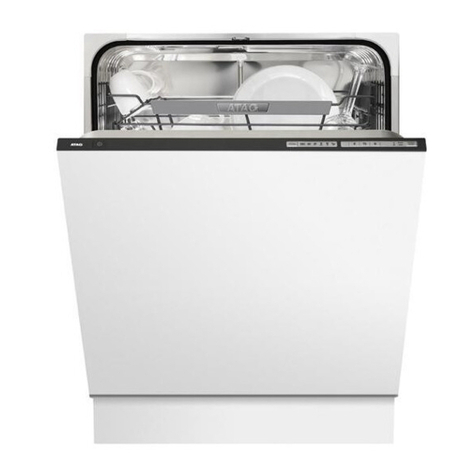
Atag
Atag VA6611NTUU/A01 User manual
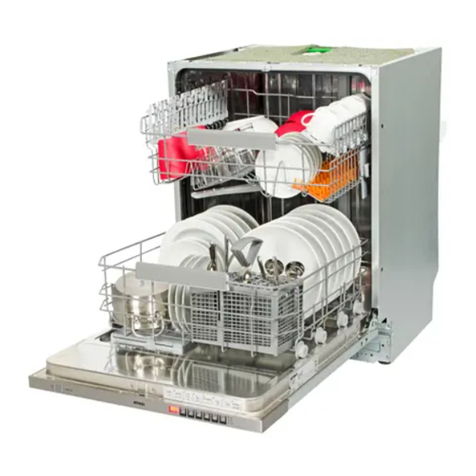
Atag
Atag VA63111ST User manual
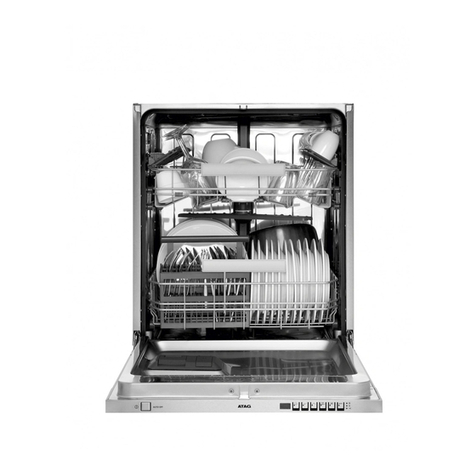
Atag
Atag VA63211ST/A01 User manual
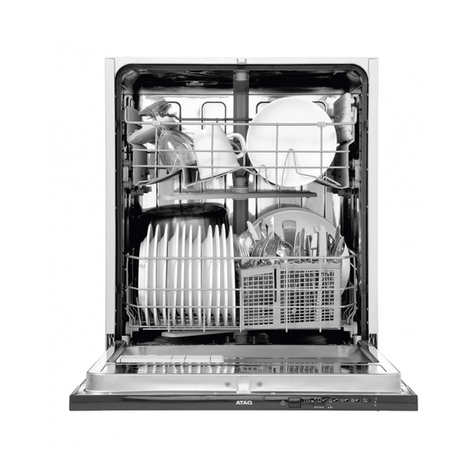
Atag
Atag VA6311LT User manual

Atag
Atag VA9711QT User manual
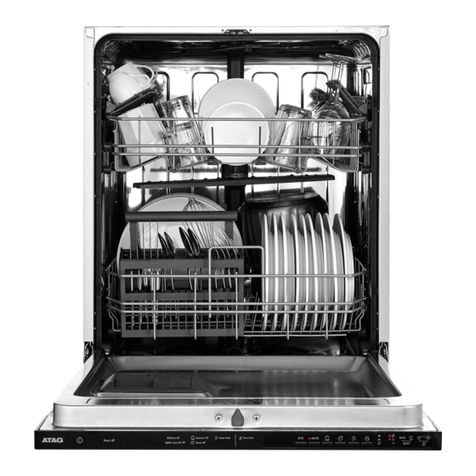
Atag
Atag VA63313LT User manual
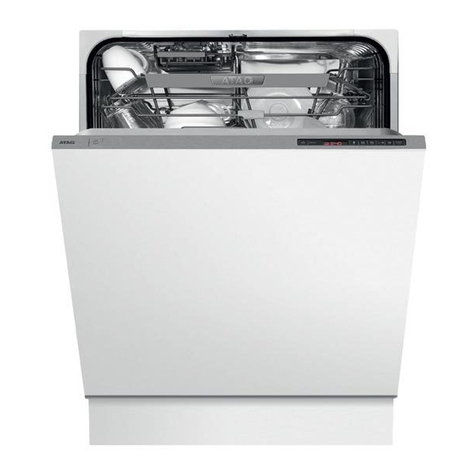
Atag
Atag VA6711TT User manual

Atag
Atag VA9611RT User manual
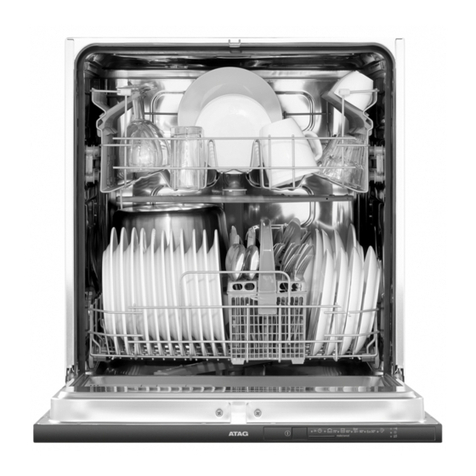
Atag
Atag VA61211KT User manual
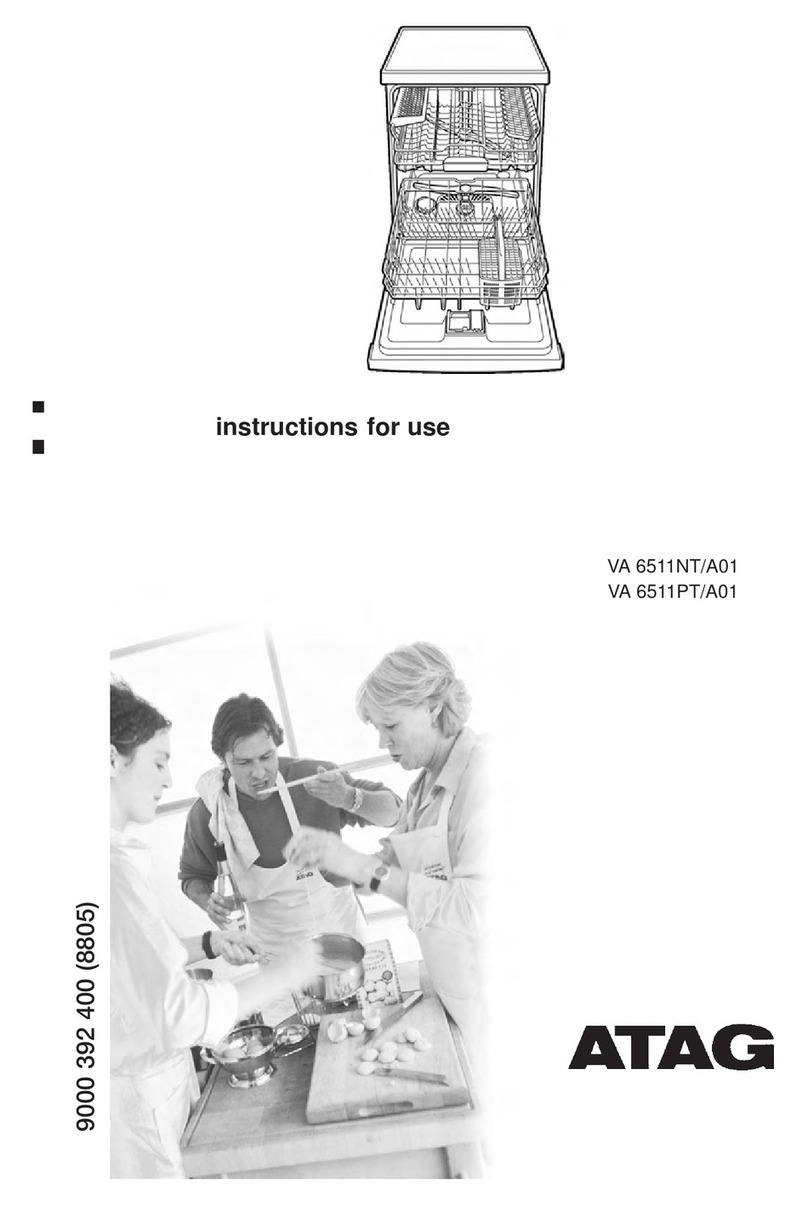
Atag
Atag VA 6511NT/A01 User manual
